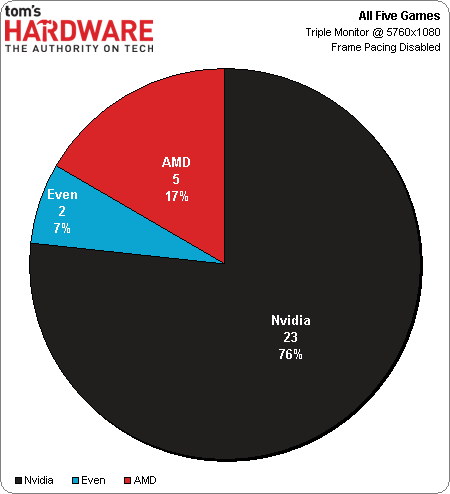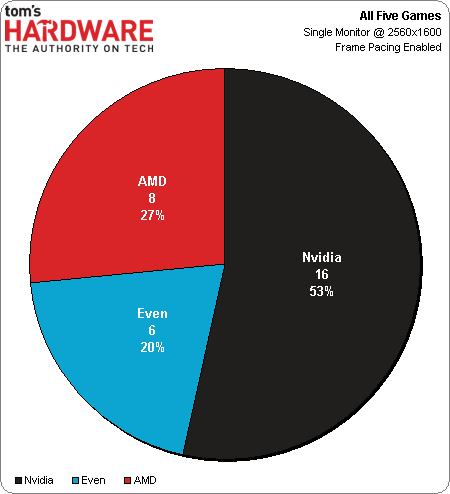Radeon HD 7990 Vs. GeForce GTX 690: The Crowd Picks A Winner
Tom's Hardware enlists the help of /r/Bakersfield, plus some of its Facebook community, to test AMD's Radeon HD 7990 with the latest Catalyst 13.8 beta driver against GeForce GTX 690. The all-day event turned up some interesting observations.
Catalyst 13.8 Beta Makes A Difference
Like Don pointed out yesterday, the situation today is far better for Radeon HD 7990 owners than it was at launch. You’re particularly happy if you bought the 7990 after AMD dropped its price to about $700.
Yesterday, we presented data showing that Catalyst 13.8 improves average frame rates a bit, minimum frame rates by substantially more, and significantly hacks into the consecutive frame time variance that the Radeon HD 7990 suffered when it launched. This is great news. It shows that AMD went back and, even though it believed it was doing things the right way—rendering frames as quickly as possible—still wanted to give gamers concerned about smoothness and consistency an option to meter the rate at which frames appear. In fact, it’s making that option the default setting in Catalyst 13.8.
Don’s comparison pit the Radeon HD 7990 with Catalyst 13.6 Beta 2 against the same card with Catalyst 13.8 Beta and GeForce GTX 690 with a beta driver from Nvidia. The outcome was inconclusive, in his opinion. Results from FCAT didn’t always correspond with the videos he captured and uploaded.
Today’s story complements his work by putting it next to the opinions of a room full of people who sat in front of two systems for an entire day, not knowing what each box contained, and gave us their opinions as to which one was more enjoyable. That’s powerful stuff.
Of course, one system had a GeForce GTX 690 in it. The other had AMD’s Radeon HD 7990. We tried a couple of different permutations: with three 24” Dell monitors in a 5760x1080 configuration, and with one 30” Dell screen running at 2560x1600. Frame pacing isn’t supported yet in multi-monitor arrays though, so the Eyefinity-based results reflect AMD’s driver without the benefit of its new feature. If a vote for “no difference” is awarded to both companies, then AMD scores seven votes like that, while Nvidia garners 25.
Ditching the triple-screen setup (which is a shame—we really hope the update with frame pacing support in Eyefinity arrives soon) for one 30” monitor at 2560x1600 kicks this capability into gear, and really affects what a fresh group of testers thought of AMD’s performance. Again, giving credit to both companies when a respondent can’t pick a favorite, AMD doubles its score to 14 votes, while Nvidia drops to 22.
That’s still a fairly significant advantage pointing to the GeForce GTX 690 as a better-performing dual-GPU card. Keep in mind, though, that we discovered a significant issue with Metro: Last Light, which gave Nvidia six votes to AMD’s zero. If Metro ran properly, the two dual-GPU cards might have come close to tying!
Get Tom's Hardware's best news and in-depth reviews, straight to your inbox.
So, the 7990’s issues aren’t completely worked out yet. Eyefinity, OpenGL, and DirectX 9 still aren’t supported by the frame pacing component of AMD’s Catalyst suite. There’s a phase-two driver on the way to rectify this, but the company isn’t commenting on when it might land. And two 7990s in four-way CrossFire still aren’t a viable combination (Radeon HD 7990 In CrossFire: The Red Wedding Of Graphics).
However, the improvements are undeniable. They’re evident in Don’s objective data, and they’re evident from the event I ran in Bakersfield with gamers subjectively picking their favorite experiences. AMD clearly deserves recognition for listening to feedback and implementing the features its customers asked for. As a result, more people enjoy the Radeon HD 7990. This is good.
We’re not ready to button this topic up and call it satisfactorily concluded, though. Don and I both benchmarked Radeon HD 7990s. Do our findings map over to other single-GPU cards in AMD’s line-up running in CrossFire? The answer to that question will determine whether multi-card Radeon configs show back up in Best Graphics Cards For The Money. If so, you’ll probably find us backing a pair of Radeon HD 7970s, rather than the 7990, anyway.
Current page: Catalyst 13.8 Beta Makes A Difference
Prev Page Results: Metro: Last Light Next Page In Pictures: Tom's Hardware's Graphics Testing Event-
iam2thecrowe can you please show cpu useage before and after the driver update, and also show results on a lower end system, like an fx6300 with dual 7850's? That would be interesting.Reply -
bin1127 A great article with some very interesting results.Reply
Chris really knows use funny and imaginative metaphors to start of his articles. Keep up the good work! -
iam2thecrowe can you please show cpu useage before and after the driver update, and also show results on a lower end system, like an fx6300 with dual 7850's? That would be interesting.Reply -
merikafyeah If I had $700 to spend on graphics, I'd buy the fastest single-gpu card there is:Reply
The Galaxy GeForce GTX 780 HOF Edition
http://www.hardocp.com/article/2013/08/14/galaxy_geforce_gtx_780_hof_edition_review/
http://www.amazon.com/dp/B00DZIFN4M/
Out of the box it beats the Titan in pretty much everything and when overclocked I'd bet performance would be indistinguishable from a GTX 690. And did I mention single GPU? Frame-pacing = non-issue. And those temps/noise ratios are in a league of their own. -
iam2thecrowe Reply11482712 said:If I had $700 to spend on graphics, I'd buy the fastest single-gpu card there is:
The Galaxy GeForce GTX 780 HOF Edition
http://www.hardocp.com/article/2013/08/14/galaxy_geforce_gtx_780_hof_edition_review/
http://www.amazon.com/dp/B00DZIFN4M/
Out of the box it beats the Titan in pretty much everything and when overclocked I'd bet performance would be indistinguishable from a GTX 690. And did I mention single GPU? Frame-pacing = non-issue. And those temps/noise ratios are in a league of their own.
you are pretty much right on there. people often overlook galaxy cards (i know i do), for obvious reasons (quality/after sales support) . but this card is insane, with extremely good OC capabilities. If i had a choice between this and a 690, i would certainly take this card. Althogh i would take 2 x of the cheapest 770's available before any of the mentioned cards. -
AndrewJacksonZA I think the most important part of this article is this little gem:Reply
"My wife is in the background with our then-two-week-old baby girl"
Congratulations Chris!!! :-) -
geok1ng With due respect for TH efforts on the subject, but keeping Metro LL results is a BIAS. How about some piecharts WITHOUT METRO LL?Reply -
Bill Reinhardt You know how wine is matched for optimal flavor compatability with certain foods?Reply
http://en.wikipedia.org/wiki/Wine_and_food_matching
You should have done that with beer and video games. -
Iron_Sean Why did you only test Triple monitors with no frame pacing versus single high res monitor with frame pacing?Reply
You're confounding variables and making your results hard to compare directly: Is the difference 6 MP vs 4 MP, frame pacing, or their crossfire/surround technology? This is an interesting idea, but I'd really like to see it narrowed to a single variable to better compare the technologies.


